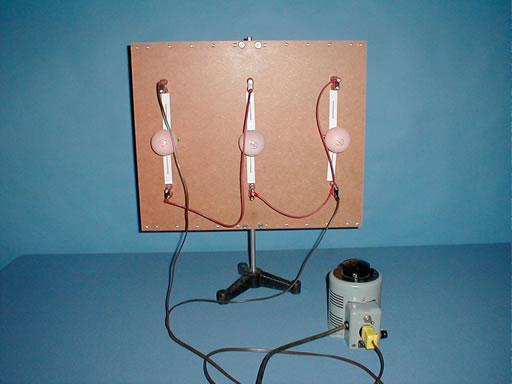Demos: 5B-06 Series and Parallel Bulbs

The circuit shown can be utilized to show the effects of resistors in parallel, in series and combinations of the two.
Directions: Switch S1 is a single-pole, double throw switch. S is the main switch for activating the circuit. First place S1 in the “x” position and leave S2 open. This gives you one bulb in the circuit when S is closed. To display two bulbs in series, place S1 in the “y” position. (This makes a direct path from A to B, shorting out the parallel circuit.) To show two bulbs in parallel, place S1 in the “x” position and close S2. (This bypasses the series bulbs.) Series/parallel combination: S1 open, S2 closed.
Suggestions for Presentation: Using bulbs rather than common resistors allows for a visual presentation of what happens in various combinations. However, the resistance of a light bulb depends on its operating temperature. So when you are comparing two bulbs in series with two bulbs in parallel, you are not strictly comparing series to parallel with the same resistors. But, the two bulbs will be brighter in the parallel combination and dimmer in the series combination--just not the 1/2 factor that might be expected.
Extension: For the parallel arrangement, make the two bulbs significantly different, i.e. a high wattage and a low wattage. As expected, the high wattage will burn brightly and the low wattage will burn much dimmer. Now go back to the series arrangement and use the same two bulbs. Ask the students which will be brighter. The big surprise is that the “high wattage” bulb will hardly be visible (or very dim) and the “low wattage” bulb will be brighter than the “high wattage” (but dimmer than it was before). This is unexpected and gives you an opportunity to explore the various aspects of voltage, current and resistance in series and parallel circuits.
Applications:
Last Updated: Nov 30, 2023 11:25 AM